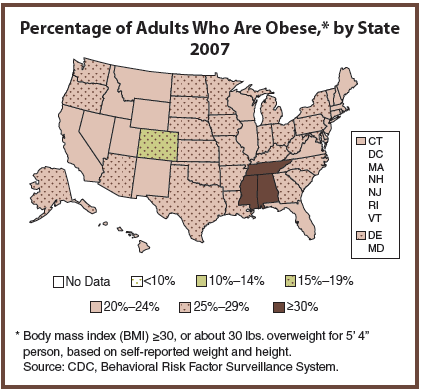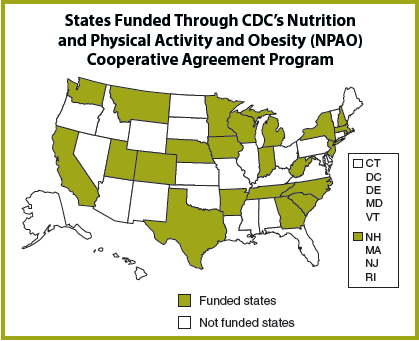 |

|
 |
 |
 |
OBESITY
Halting the Epidemic by Making Health Easier
At A Glance
2009

The Obesity Epidemic
More than one third of U.S. adults—more than 72 million people—and
16% of U.S. children are obese. Since 1980, obesity rates for adults
have doubled and rates for children have tripled. Obesity rates among
all groups in society—irrespective of age, sex, race, ethnicity,
socioeconomic status, education level, or geographic region—have
increased markedly.
Health Consequences of Obesity
Obesity has physical, psychological, and social consequences in adults
and children. Children and adolescents are developing obesity-related
diseases, such as type 2 diabetes, that were once seen only in adults. Obese
children are more likely to have risk factors for cardiovascular disease,
including high cholesterol levels, high blood pressure, and abnormal glucose
tolerance. One study of 5- to 17-year-olds found that 70% of obese children
had at least one risk factor for cardiovascular disease and 39% of obese
children had at least two risk factors.
Obesity is Costly
- In 2000, obesity-related health care costs totaled an estimated $117
billion.
- Since 1987, diseases associated with obesity account for 27% of the
increases in medical costs.
- Medical expenditures for obese workers, depending on severity of
obesity and sex, are between 29%–117% greater than expenditures for
workers with normal weight.
- From 1979–1981 to 1997–1999, annual hospital costs related to
obesity among children and adolescents increased, rising from $35
million to $127 million.
Halting Obesity Requires Policy and Environmental Change Initiatives
The determinants of obesity in the United States are complex, numerous,
and operate at social, economic, environmental, and individual levels.
American society has become ‘obesogenic,’ characterized by environments that
promote increased food intake, nonhealthful foods, and physical inactivity.
Public health approaches that affect large numbers of different populations
in multiple settings—communities, schools, work sites, and health care
facilities—are needed. Policy and environmental change initiatives that make
healthy choices in nutrition and physical activity available, affordable,
and easy will likely prove most effective in combating obesity.
|
The Health
Consequences of Obesity
- Coronary heart disease
- Type 2 diabetes
- Cancer (endometrial, breast, and colon)
- Hypertension (high blood pressure)
- Dyslipidemia (high total cholesterol or high levels of
triglycerides)
- Stroke
- Liver and gallbladder disease
- Sleep apnea and respiratory problems
- Osteoarthritis (degeneration of cartilage and underlying
bone within a joint)
- Gynecological problems (abnormal menses, infertility)
|
|

[A text description of this map is also available.]
CDC’s Response
CDC’s Division of Nutrition, Physical Activity, and Obesity (DNPAO) is
working to reduce obesity and obesity-related conditions through state
programs, technical assistance and training, leadership, surveillance
and research, intervention development and evaluation, translation of
practice-based evidence and research findings, and partnership
development.
Supporting State-Based Programs
Currently, 23 states are funded through CDC’s Nutrition and Physical
Activity and Obesity (NPAO) Cooperative Agreement Program that coordinates
statewide efforts with multiple
partners to address obesity.
The program’s focus is on policy and environmental change initiatives
directed towards increasing physical activity; consumption of fruits and
vegetables; breastfeeding initiation, duration, and exclusivity; and
decreasing television viewing and consumption of sugar-sweetened beverages
and high-energy dense foods (foods high in calories). The program seeks to
address health disparities and requires a comprehensive state plan.
Providing Technical Assistance and Training
CDC provides technical assistance to all states to develop comprehensive
state plans, community interventions, and leadership capacity to address
obesity. Our new Program Technical Assistance Manual provides a one-stop
reference for NPAO program guidance. CDC also provides training
to public health practitioners. In 2008, CDC cosponsored an obesity
prevention course focused on policy and environmental change strategies with
the Center of Excellence for Training and Research Translation at the
University of North Carolina.
Convening National Leadership Activities
CDC is leading the development of the National Roadmap for Obesity
Prevention and Control, expected in 2010. Two conferences convened in 2008
were stepping stones toward the Roadmap: the National Summit on Legal
Preparedness for Obesity Prevention and Control and Community Approaches to
Address Obesity. These conferences also laid the groundwork for the Weight
of the Nation Conference, scheduled for summer 2009, which will highlight
progress in obesity prevention and control and identify actions needed to
reverse the epidemic.
Surveillance and Epidemiologic Research
CDC monitors obesity trends and conducts and supports research on obesity
prevention and control strategies. Through our research activities, we do
the following:
- Identify, translate, implement, and evaluate effective or promising interventions for obesity prevention and control.
- Describe and track priority policy, environmental, behavioral, and
demographic correlates of obesity and overweight.
- Identify the measures of obesity that best characterize children
and adults with increased risk for adverse health outcomes.
|
Progress in Obesity: Recent Findings
Early signs of
success in the prevention and control of obesity—at both state
and national levels—are now emerging. Major CDC surveys have
found no significant increase in obesity prevalence among
children, adolescents, women or men between 2003–2004 and
2005–2006. Also, obesity rates appear to be leveling among
children in some states such as Arkansas.
CDC’s efforts have
helped increase awareness of obesity as a national public health
problem. During 2000–2007, media coverage on obesity in national
print and newswires increased from about 8,000 to more than
28,000 articles.
A variety of
innovative policy and environmental changes in communities, work
sites, and schools are likely contributing to this progress. |
|
Developing Innovative Partnerships
CDC is making progress in halting the obesity epidemic through innovative
partnerships.
- The Healthy Eating Active Living Convergence Partnership (CP)
seeks to foster policy and environmental change through innovative
partnerships with others from fields not traditionally involved in
public health. CP is currently focused on transportation and food
systems to develop active living environments and improve access to
healthy foods. (Partners: California Endowment, Kaiser Permanente,
Nemours, Robert Wood Johnson Foundation, W.K. Kellogg Foundation,
PolicyLink, Prevention Institute)
- Common Community Measures for Obesity Prevention (Measures
Project) fills two crucial gaps hindering obesity efforts—the
absence of standard measures for community-level policy and
environmental change initiatives and a tool for monitoring these
initiatives. The project developed 26 measures and a Web-based tool that
local governments can use to assess them. Following pilot testing in 20
communities, the measures will be available nationwide. (Partners:
Robert Wood Johnson Foundation, W.K. Kellogg Foundation, Kaiser
Permanente, CDC Foundation, International City/County Management
Association, Macro International Inc.)
- Early Assessment of Programs and Policies to Prevent Childhood
Obesity is identifying a set of promising local programs and
policies and determining which ones merit rigorous evaluation. Priority
is placed on programs and policies implemented in community settings
targeting low-income children to improve eating habits and physical
activity levels. (Partners: Robert Wood Johnson Foundation, Division of
Adolescent and School Health [CDC], Prevention Research Centers Program
Office, CDC Foundation, Macro International Inc.)
- Addressing Obesity Through Commercial Health Plans. CDC is
working to help public health professionals and health care plan
administrators collaborate to improve obesity interventions designed for
medical settings. (Partner: Deloitte Consulting)
Identifying Setting-Specific, Evidence-Based Guidelines for Obesity
Interventions
In collaboration with the Task Force on Community Preventive Services
(the Community Guide), CDC is conducting evidence-based reviews of obesity
interventions in three settings—medical care, work sites, and communities.
Translating Practice-Based Evidence and Research
CDC translates practice-based evidence and research findings for use by
practitioners, communities, and the public. Recent translation products
include the following:
- The Lean for Life Web site (expected launch spring 2009,
http://www.cdc.gov/leanforlife) guides companies in planning, building,
promoting, and evaluating obesity prevention and control programs. It
projects the cost of obesity and expected financial return from
implementing a program.
- The Swift Work Site Assessment
and Translation (SWAT) (http://www.cdc.gov/swat)evaluation method assesses work site
health promotion programs that help employees attain or maintain a
healthy body weight.
- Healthy Weight Web
site (http://www.cdc.gov/healthyweight) includes a BMI calculator and provides consumers with
relevant steps and tools to help them understand how to achieve and
maintain a healthy weight for a lifetime.
- The Weight Management
Research to Practice Series (http://www.cdc.gov/weightr2p) summarizes the science on various
weight management topics, highlighting the implications of the research
findings for public health and medical care professionals.
Back to top
Successes and Opportunities for Population-Level
Prevention
and Control
Success Stories
Michigan: Building Healthy Communities
Michigan’s Building Healthy Communities Project is designed to improve
the environment and change policies to make it easier for residents to be
healthy. Local health departments were supported through funding and
technical assistance to form community coalitions and develop 3-year plans
for creating more opportunities for their residents to engage in healthful
eating, physical activity, and tobacco-free lifestyles. Coalitions included
representatives from local transportation, zoning and planning departments,
law enforcement, the YMCA, hospitals, universities, nonprofit organizations,
news media outlets, in addition to farmers, residents, public officials, and
city engineers.
The Building Healthy Communities Project achieved significant success in
making it easier for Michigan residents to be healthy by
- Creating or enhancing 11 trails covering 58.6 miles.
- Enhancing 7 parks with amenities such as new equipment, benches, and
lighting.
- Providing residents with 14,000 walking maps.
- Conducting 129 community fitness classes.
- Opening 5 new farmers’ market locations with the ability to process
Electronic Benefit Transfer capabilities for processing for food stamps.
- Creating 7 new school and community gardens.
- Distributing 5,000 coupon books to low-income seniors to redeem for
fresh fruits and vegetables.
Texas: Farm to Work Delivers
In 2005, less than one quarter of Texas adults ate the minimum amount of
fruits and vegetables recommended for good health. To increase access to
fresh produce, the Texas Department of State Health Services Nutrition,
Physical Activity, and Obesity Prevention Program worked with the
department’s Building Healthy Texans Employee Wellness Program to create a
Farm to Work program. This program enables employees at 10 Austin-area work
sites to purchase fresh local produce, which is delivered weekly to their
work site. Coordination with local farmers is handled by the Sustainable
Food Center, a nonprofit organization. Participation is easy—employees order
on a week-by-week basis, with no subscription required. Orders are prepaid
through a secure server so no money is handled onsite. A Farm to Work tool
kit was created and disseminated. Other state agencies and private companies
in Texas are now implementing similar programs.
Employees took advantage of the program and saved money. In 1 year, 1,700
employees participated; 82,000 pounds of fresh local produce were delivered;
and Central Texas farmers made $160,000 in sales. An informal cost
comparison showed that grocery store produce was more expensive than the
Farm to Work produce.

[A text description of this map is also available.]
California: California Convergence Partnership
Modeled after the national Convergence Partnership, the
California Convergence is a statewide initiative that provides a unique
opportunity not only to accelerate the movement to prevent obesity in
California, but to promote learning and synergy across programs by bringing
together seven separate funders—The California Endowment, Kaiser Permanente,
the Robert Wood Johnson Foundation, the W.K. Kellogg Foundation, the U.S.
Department of Health and Human Services, the California Department of Public
Health, and the Centers for Disease Control and Prevention. The California
Convergence partnership strategically connects existing resources, and
creates an effective learning community that can take action and share
information, tools, and resources across initiatives and funding streams to
create healthy environments where people can thrive.
 To create healthier communities across California, the California
Convergence pursues the following goals:
To create healthier communities across California, the California
Convergence pursues the following goals:
-
Shift the public and political discussion regarding
obesity prevention to emphasize improving nutrition and physical
activity environments.
-
Accelerate local and state policy efforts to change
nutrition and physical activity environments to improve health.
-
Strengthen the network of leaders in California that are
on the front lines in developing and implementing strategies to improve
food and activity environments.
-
Increase opportunities for leaders and community
coalitions to build their capacity and leadership skills to support this
work.
Through the California Convergence, leaders from 26
communities are working collectively to develop a common policy agenda,
build a statewide communication infrastructure, influence funding
strategies, and generate public revenue to support their work including the
following:
-
Policy Change. Convene local and state policy
advocates to support local—and eventual statewide—adoption of
high-impact policy strategies.
-
State Conference. Bring leaders together in a
statewide conference to share strategies and lessons, resources, and
tools.
-
Leadership Building and Peer Networking. Create
opportunities for local leaders to learn from each other.
-
Skill Building. Communicate policy and systems
change issues to decision makers and the public.
-
Growing the Movement. Prepare local leaders to
participate in the 2009 Childhood Obesity Prevention Conference.
Back to top
Related Materials
Back to top
|
For more information please contact
Centers for Disease Control and Prevention
National Center for Chronic Disease Prevention and Health Promotion,
4770 Buford Highway NE,
Mail
Stop K–24, Atlanta, GA 30341-3717
Telephone: 800-CDC-INFO (232-4636) • TTY: 888-232-6348
E-mail: cdcinfo@cdc.gov • Web:
http://www.cdc.gov/nccdphp/dnpa
|
|
 One or more documents on this Web page is available in Portable Document Format
(PDF). You will need Acrobat
Reader (a free application) to view and print these documents.
One or more documents on this Web page is available in Portable Document Format
(PDF). You will need Acrobat
Reader (a free application) to view and print these documents.
Page last reviewed: December 10, 2008
Page last modified: December 10, 2008
Content source: National Center for
Chronic Disease Prevention and Health Promotion
|
 |


 To create healthier communities across California, the California
Convergence pursues the following goals:
To create healthier communities across California, the California
Convergence pursues the following goals:![]() One or more documents on this Web page is available in Portable Document Format
(PDF). You will need Acrobat
Reader (a free application) to view and print these documents.
One or more documents on this Web page is available in Portable Document Format
(PDF). You will need Acrobat
Reader (a free application) to view and print these documents.